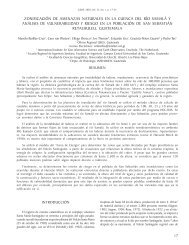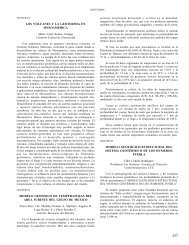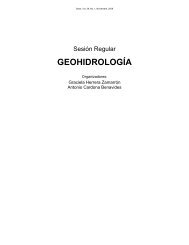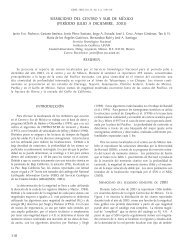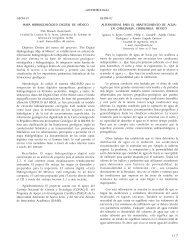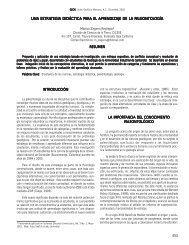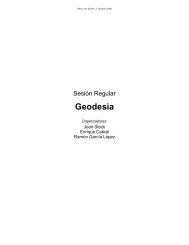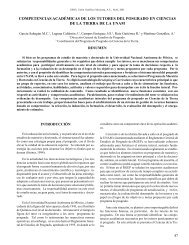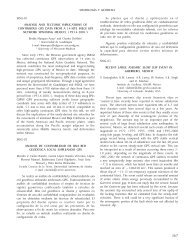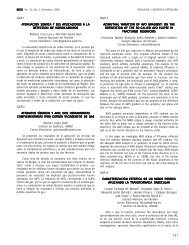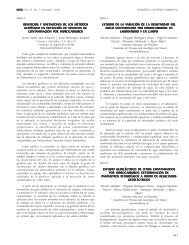Libro de Resúmenes - Unión Geofisica Mexicana AC
Libro de Resúmenes - Unión Geofisica Mexicana AC
Libro de Resúmenes - Unión Geofisica Mexicana AC
You also want an ePaper? Increase the reach of your titles
YUMPU automatically turns print PDFs into web optimized ePapers that Google loves.
Geos, Vol. 30, No. 1, Noviembre, 2010<br />
FÍSICA ESP<strong>AC</strong>IAL<br />
FE-8<br />
TLAM<strong>AC</strong>AS MOUNTAIN AS AN ANOMALY<br />
AREA IN THE POPOCATEPETL VOLCANO<br />
Kotsarenko Anatoliy 1 , Yutsis von Brinken Visvaldis 2 , Grimalsky Vladimir 3 , Medina Pérez<br />
Luis 3 , Koshevaya Svetlana 3 , Pérez Enríquez Román 1 y López Cruz Abeyro José 1<br />
1 Centro <strong>de</strong> Geociencias, UNAM<br />
2 Facultad <strong>de</strong> Ciencias <strong>de</strong> la Tierra, Universidad Autónoma <strong>de</strong> Nuevo León<br />
3 Centro <strong>de</strong> Investigación en Ingeniería y Ciencias<br />
Aplicadas, Universidad Autónoma <strong>de</strong>l Estado <strong>de</strong> Morelos<br />
kotsarenko@geociencias.unam.mx<br />
Results of the combined Radon and Gamma spectroscopy survey in the<br />
area of the Tlamacas mountain, volcano Popocatepetl, indicate presence of<br />
the highly enchanced Radon emanation in the localized area of Tlamacas<br />
mountain and also elevated level of Gamma rays. Obtained results can indicate<br />
presence of high tectonic actvity localized in the mountain area. They can also<br />
explain permanent noise in the magnetic components previously <strong>de</strong>tected during<br />
monitoring in the Tlamacas area. Radon emanation stimulates high ionization<br />
in the air which provokes numerous discharges registered as a spike-like noise<br />
by magnetometer.<br />
FE-9<br />
CRITICAL BEHAVIOUR OF PARTICLES WITH MAGNETIC<br />
MOMENTS IN A THREE-DIMENSIONAL SPATIAL SYSTEM<br />
Burlak Gennadiy 1 y Karlovich Yuri 2<br />
1 Centro <strong>de</strong> Investigación en Ingeniería y Ciencias<br />
Aplicadas, Universidad Autónoma <strong>de</strong>l Estado <strong>de</strong> Morelos<br />
2 Facultad <strong>de</strong> Ciencias, Universidad Autónoma <strong>de</strong>l Estado <strong>de</strong> Morelos<br />
gburlak@uaem.mx<br />
In a 3D space, the nearest random particles can form long percolating<br />
clusters with complicate spatial structure. If such particles have magnetic<br />
properties than such a system gives rise to a topologically nontrivial magnetic<br />
structure, leading to new features of the critical phenomenon (phase transitions)<br />
without an external magnetic field (spontaneous magnetization). In such an<br />
inhomogeneous system, the standard mo<strong>de</strong>ls are strongly modified by the<br />
random cluster distribution in a space. We found numerically that at large<br />
occupation probability p (far from the critical value), the magnetization shows<br />
the critical behaviour, but the transition temperature Tc <strong>de</strong>pends consi<strong>de</strong>rably<br />
on the probability p. We provi<strong>de</strong> numerical evi<strong>de</strong>nce that the <strong>de</strong>pen<strong>de</strong>nce Tc<br />
(p) is affected by the no integer fractal dimension Dh of the incipient percolation<br />
spanning cluster.<br />
FE-10<br />
DIFFR<strong>AC</strong>TION PROBLEMS IN <strong>AC</strong>OUSTICS<br />
Karlovich Yuri 1 y Burlak Gennadiy 2<br />
1 Facultad <strong>de</strong> Ciencias, Universidad Autónoma <strong>de</strong>l Estado <strong>de</strong> Morelos<br />
2 Centro <strong>de</strong> Investigación en Ingeniería y Ciencias<br />
Aplicadas, Universidad Autónoma <strong>de</strong>l Estado <strong>de</strong> Morelos<br />
karlovich@uaem.mx<br />
The talk is <strong>de</strong>voted to wave diffraction problems for the two-dimensional<br />
Helmholtz equation. Boundary-transmission problems for a union of intervals<br />
(i.e., strips of a negligible thickness) which lie on a system of one or several<br />
parallel lines are consi<strong>de</strong>red in a Sobolev space setting (the finite energy norm<br />
space). These problems inclu<strong>de</strong> the mixed Dirichlet/Neumann and impedance<br />
boundary and transmission problems. Diffraction of an acoustic wave by a<br />
system of finite and semi-infinite screens has been studied for many years. The<br />
theory <strong>de</strong>pends very sensitively on the geometry of a system of screens, on the<br />
materials of the surfaces of screens which imply different boundary-transmission<br />
conditions on the screens, and on the spaces in which the problems are<br />
investigated. The inci<strong>de</strong>nt acoustic field is assumed to be time-harmonic. The<br />
problems mentioned above are reduced to equivalent systems of convolution<br />
type equations with kernels having semi-almost periodic Fourier transforms. To<br />
solve these systems we apply the theory presented in the book:<br />
[1] A. BÃttcher, Yu. I. Karlovich, and I. M. Spitkovsky: Convolution Operators<br />
and Factorization of Almost Periodic Matrix Functions. Birkhäuser, Basel 2002.<br />
FE-11 CARTEL<br />
BÚSQUEDA DE SEÑALES DE EVENTOS DE PROTONES<br />
SOLARES EN LA BASE DE DATOS DEL MONITOR<br />
DE NEUTRONES DE LA CIUDAD DE MÉXICO<br />
Vargas Cár<strong>de</strong>nas Bernardo y Valdés Galicia José Francisco<br />
Universidad Nacional Autónoma <strong>de</strong> México<br />
bernardo@geofisica.unam.mx<br />
Se realizó una búsqueda <strong>de</strong> señales <strong>de</strong> eventos <strong>de</strong> protones solares observados<br />
a nivel <strong>de</strong>l suelo (GLE) en la base <strong>de</strong> datos <strong>de</strong>l monitor <strong>de</strong> neutrones <strong>de</strong> la Ciudad<br />
<strong>de</strong> México en el período <strong>de</strong> 1989 a 2006 empleando varias técnicas estadísticas.<br />
Se calculó la significancia estadística para las variaciones observadas en la<br />
señal correspondientes a los 28 eventos <strong>de</strong> este tipo ocurridos en dicho lapso.<br />
Se encontraron varios incrementos significativos que no habían sido reportados<br />
anteriormente.<br />
FE-12 CARTEL<br />
DINÁMICA DE PICKUP IONS EN LA<br />
IONOFUNDA DE MARTE CON TURBULENCIA<br />
Aceves Campos Héctor 1 , Reyes Ruiz Mauricio 1 y Pérez <strong>de</strong> Tejada Héctor 2<br />
1 Instituto <strong>de</strong> Astronomía, UNAM, Campus Ensenada<br />
2 Instituto <strong>de</strong> Geofísica, UNAM<br />
aceves@astrosen.unam.mx<br />
Se analiza la dinámica <strong>de</strong> “pickup ions” en una magnetofunda semejante a la <strong>de</strong><br />
Marte, consi<strong>de</strong>rando la presencia <strong>de</strong> turbulencia magnética en dicho medio. Se<br />
calcula la dinámica <strong>de</strong> iones bajo los espectros <strong>de</strong> potencias para la turbulencia<br />
tipo Kolmogorov e Iroshnikov-Kraichnan.<br />
Se estudia en particular la distribución <strong>de</strong> velocida<strong>de</strong>s <strong>de</strong> los iones <strong>de</strong> O+<br />
en el terminador y se comparan los resultados con observaciones <strong>de</strong>l Mars<br />
Express. La solo dinámica <strong>de</strong> iones <strong>de</strong>bida al arrastre ExB, con o sin turbulencia,<br />
no resulta ser consistente con el dominio <strong>de</strong> la componente x-antisolar <strong>de</strong> la<br />
distribución <strong>de</strong> velocida<strong>de</strong>s observada. Otro tipo <strong>de</strong> proceso físico <strong>de</strong>be estar<br />
ocurriendo para explicar tal comportamiento.<br />
FE-13 CARTEL<br />
ANOMALIA DE RAYOS GAMMA EN LA EST<strong>AC</strong>IÓN<br />
GEOELECTROMAGNETICA DEL CGEO, CAMPUS<br />
JURIQUILLA, UNAM, EN MARZO DEL 2010<br />
López Cruz Abeyro José, Pérez Enríquez Román,<br />
Kotsarenko Anatoliy y López Montes Rebeca<br />
Centro <strong>de</strong> Geociencias, UNAM<br />
lcabeyro@geociencias.unam.mx<br />
Se reporta sobre una anomalía <strong>de</strong> rayos gamma que ocurrió el pasado mes<br />
<strong>de</strong> marzo <strong>de</strong> 2010 en el observatorio <strong>de</strong> geo electromagnetismo <strong>de</strong>l CGEO, en<br />
Juriquilla. La <strong>de</strong>tección se llevó a cabo con un contador Geiger Gamma-Scout,<br />
el cual se encuentra en un registro a 1m <strong>de</strong> profundidad a 20 m <strong>de</strong>l observatorio.<br />
El evento observado duró más <strong>de</strong> cuatro días (100 horas), iniciándose el<br />
6 <strong>de</strong> marzo. Se compararon las observaciones con los registros obtenidos<br />
anteriormente, así como con datos <strong>de</strong>l Sol, datos <strong>de</strong> campo geomagnético, <strong>de</strong>l<br />
magnetómetro <strong>de</strong> la propia estación <strong>de</strong> Juriquilla, datos ionosféricos e índice<br />
magnético Dst. Aunque no se encontró un evento relacionado en los otros<br />
parámetros, el hecho <strong>de</strong> que <strong>de</strong>spués <strong>de</strong> este periodo anómalo el contador<br />
siguió midiendo como siempre, no permite <strong>de</strong>scartar el evento como legítimo.<br />
FE-14 CARTEL<br />
STUDY OF PERIODICITIES OF RSP AND OF<br />
GCR PRIOR TO RSP EVENTS OCURRENCE<br />
Pérez Peraza Jorge 1 , Velasco Herrera Victor 1 y Zapotitla Roman Julian 2<br />
1 Instituto <strong>de</strong> Geofísica, UNAM<br />
2 Facultad <strong>de</strong> Ingeniería, UNAM<br />
perperaz@yahoo.com.mx; perperaz@geofisica.unam.mx<br />
In this work we attempt to <strong>de</strong>termine characteristic signatures of Ground Level<br />
Enhancements (GLE) of Relativistic Solar protons (RSP) events that could be<br />
associated to the source processes at the Sun. We also search for signatures<br />
in the GCR background before the occurrence of RSP events that could be<br />
consi<strong>de</strong>red as precursors for forecasting goals. Among the periodicities found in<br />
this work, it is to mention the short-term (ST) periodicities, in the or<strong>de</strong>r of days,<br />
all of them are harmonics of the 11-year solar activity cycle, and the ultra-short<br />
term (UST)periodicities, in the or<strong>de</strong>r of minutes-hours. The synchronization of<br />
some of these periodicities with those of sub-photospheric and coronal layers<br />
seems to indicate that RSP production is not a local phenomenon, but involves<br />
global regions of the Sun’s atmosphere, and to some extent the whole motion of<br />
23



![Libro de resúmenes [revisión final, 172 páginas] - UGM](https://img.yumpu.com/51565067/1/190x245/libro-de-resamenes-revisian-final-172-paginas-ugm.jpg?quality=85)
